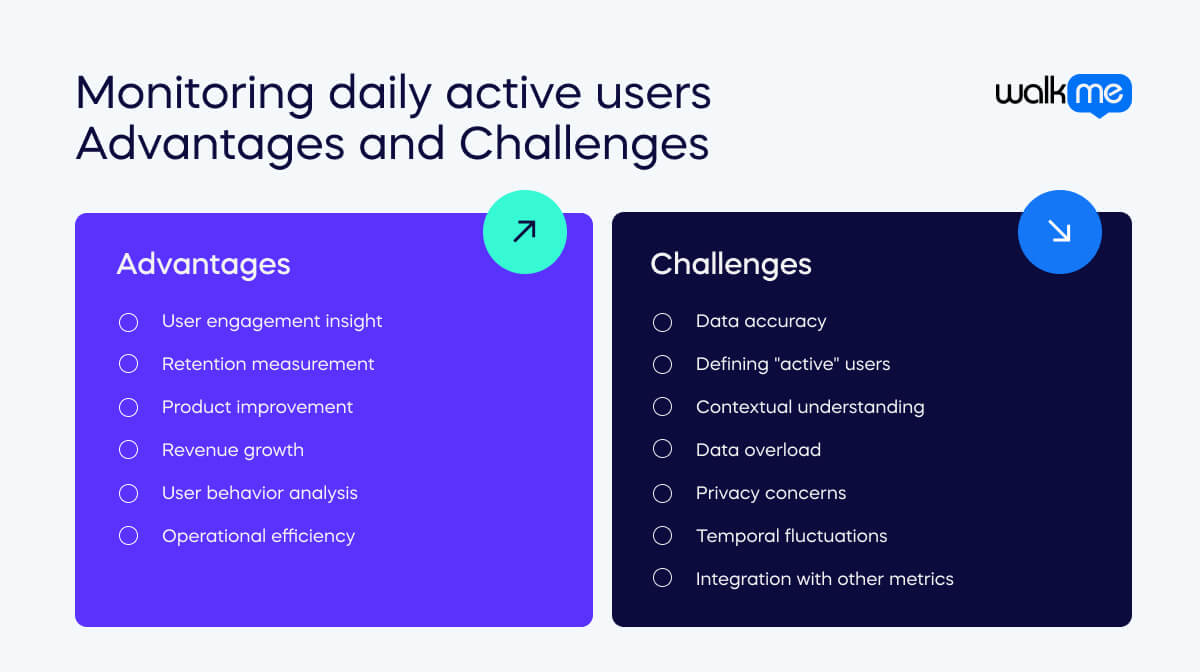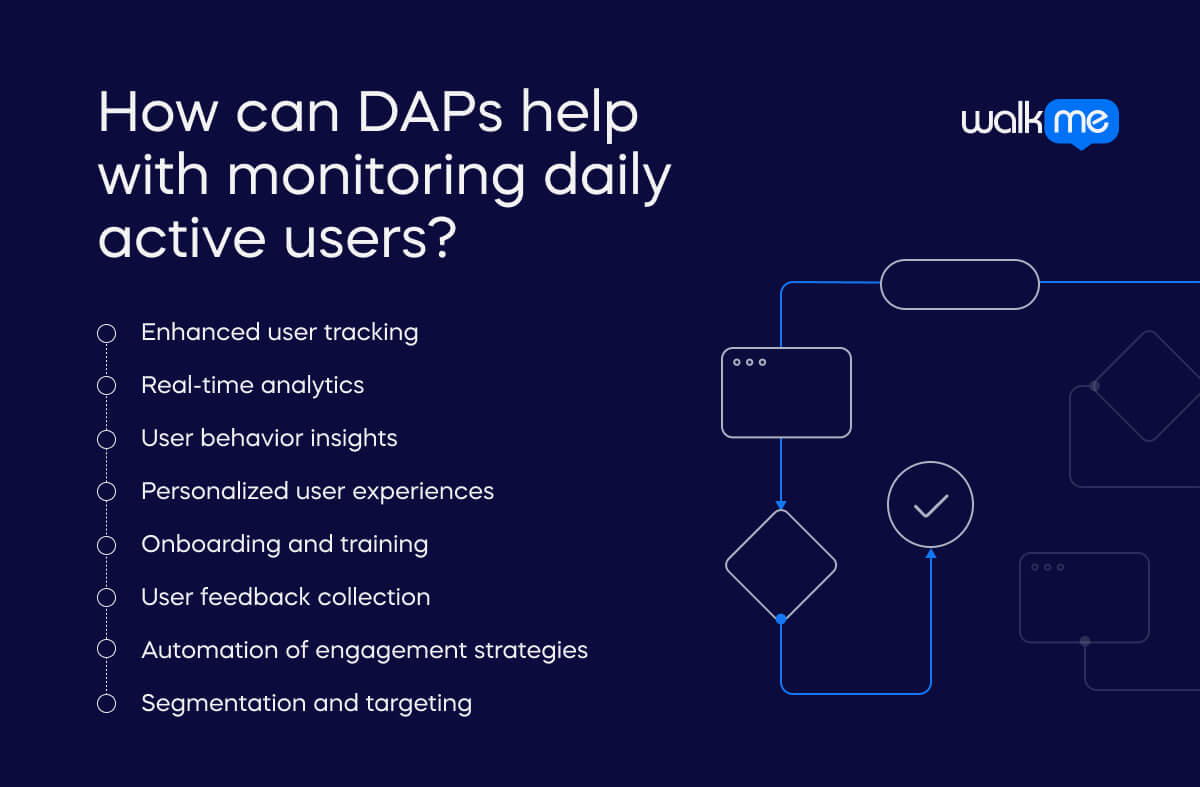Daily active users (DAU) is a metric measuring the number of unique users interacting with a digital product, like an app. As the name suggests, it specifically examines numbers within a 24-hour period.
It’s important for businesses and developers who want to understand how often users return to use the product. They can also understand how engaged they are with the features and content.
When companies monitor DAU, they can assess whether the product is being used regularly and project whether it is likely to grow. If there are many daily active users, this indicates a strong interest and satisfaction with the product. However, if there is a decline in DAU, this could mean there are issues with maintaining interest, keeping the product relevant, or with competitors.
In other words, analyzing DAU trends helps organizations make informed decisions about how to improve user engagement and retain their users. For example, they may make
data-driven decisions to develop new features, increase marketing, or improve customer support.
Becoming increasingly data-driven is important for modern-day business. Gartner predicts that
more than a quarter of Fortune 500 CDAOs will be responsible for one or more products based on data and analytics by 2026.
What are the key features of daily active users?
![the key features of daily active users (1)]()
On a basic level, DAU tells companies how many users are interested in their product. However, it’s advisable to drill deeper to report on this metric effectively.
Here are the key features analysts tend to consider when assessing customer retention and engagement for a digital product.
Unique user count
First up is this measure, which looks at the number of unique users who engage with the product within 24 hours. This is a good place to start, as the numbers will reflect the product’s reach. It can be more useful than other metrics, which may double-count the same user across multiple sessions.
Frequency of use
Once the reach has been understood, it’s time to dig into the frequency of use. This will help businesses understand how often people return to the product within a specific period. If plenty of people make return visits, it shows that users are engaging well and habitually using the product. However, if the frequency is low, there could be issues with customer satisfaction and retention. By keeping track of this metric, businesses can identify patterns and make data-driven decisions for improvement.
User segmentation
To explore the user base even further, organizations can categorize daily active users based on demographics, behavior, or other criteria. When this data is applied to a report, companies can understand which segments are most engaged and which may need additional focus. In turn, this informs marketing and development strategies, which can be tailored to different user groups.
Engagement metrics
Engagement metrics can help companies gain a deeper understanding of how users interact with the product each day. This data provides indicators such as time spent, actions taken, and features used. If there is high engagement, it typically means users are satisfied, and the product is a success. Therefore, companies can focus on future enhancements and updates to do even better.
Retention rates
Analysts should examine retention rates to understand whether a product will work long-term. This metric examines the percentage of users who return to the product day after day. If retention rates are high, companies can rest assured that the product is effectively meeting user needs. However, if retention rates are low, this could indicate a need for changes or improvements.
Daily active users vs. monthly active users
It can be useful for companies to measure daily and monthly active users. As the names suggest:
- DAU reflects the number of unique users who interact with the product each day
- MAU measures the unique users over the course of a month.
Understanding both metrics gives companies a comprehensive view of user behavior and product performance. However, knowing the difference between the terms is the first step. Let’s take a closer look:
| Daily active users |
Monthly active users |
| Definition |
The number of unique users who engage with a digital product within a 24-hour period. |
The number of unique users who interact with a digital product over a 30-day period. |
| Focus |
Daily engagement tracks how many users return daily to use the product. Highlights immediate user activity and daily retention. |
Longer-term engagement, monitoring how many users stay active over a month. Provides insights into overall retention and the product’s ability to maintain user interest over time. |
| Techniques |
- Daily notifications
- Limited-time offers
- Daily content updates
These strategies encourage users to return regularly. |
- Monthly newsletters
- Ongoing events or challenges
These updates keep users coming back over weeks and months. |
| Goals |
Maximize daily user interactions. This indicates strong habitual use and high short-term engagement. |
Achieve a high number of returning users over a month. This reflects sustained interest and long-term retention. |
| Examples of use |
- Tracking daily login numbers for a social media app
- Monitoring daily play counts for a game
- Analyzing daily transaction counts for an e-commerce site
|
- Measuring monthly login statistics for a productivity tool
- Assessing monthly active participants in an online course
- Evaluating monthly usage rates for a subscription-based service
|
Use cases for daily active users
Daily active users (DAU) is a crucial metric in various business scenarios.
It can measure engagement on a social media platform, track player activity in a mobile game, or monitor shopper interactions on an e-commerce site.
DAU provides valuable insights into user behavior, but it can be tough to understand how it works in everyday life.
With that in mind, here are three examples to illustrate DAU in action:
Social media platform
A social media company measures its DAU to understand how many users are actively engaging with the platform on a daily basis.
They look at the following:
- Content interaction: The number of users logging in daily to like, share, or comment on posts.
- Message activity: Users send messages or engage in group chats each day.
- Feature usage: The frequency with which people use specific features such as stories, live streaming, or new updates introduced on the platform.
Mobile gaming application
A mobile gaming company tracks DAU to measure the engagement levels of players with their games.
They examine:
- Game sessions: The count of unique players who open and play the game at least once a day.
- In-game purchases: The number of users making in-app purchases daily.
- Event participation: Daily active participation in special in-game events or challenges.
E-commerce platform
An e-commerce site monitors DAU to assess how frequently users visit their platform for shopping activities.
They make a point of tracking:
- Site visits: Unique visitors logging in or browsing the platform daily.
- Transactions: Unique daily users make purchases or add items to their cart.
- Customer support interaction: The number of users contacting customer support or using chatbots for daily queries and assistance.
![Monitoring daily active users Advantages and Challenges (1)]()
What are the advantages of monitoring daily active users?
Monitoring daily active users offers many advantages for businesses. By tracking this metric, companies gain valuable insights into how their products and services are being utilized.
This understanding helps enhance user experience, improve retention, and drive revenue growth.
Let’s look at the benefits of monitoring DAU in more detail.
User engagement insight
Tracking DAU helps businesses understand how many users are actively interacting with their product or service daily. This metric provides insights into user engagement levels, highlighting the platform’s popularity and relevance.
Retention measurement
DAU is a critical indicator of user retention. By comparing DAU over time, businesses can gauge how well they are retaining users and identify trends that may indicate issues with user satisfaction or loyalty.
Product improvement
Regular monitoring of DAU helps identify which features are most popular among users and which are not being utilized. This information is valuable for product development teams to make data-driven decisions on improving or introducing new features.
Revenue growth
A higher DAU often correlates with increased revenue for businesses that rely on user activity for revenue, such as ad-based platforms or subscription services. Monitoring this metric helps forecast revenue trends and make strategic business decisions.
User behavior analysis
Businesses can segment users based on activity levels by analyzing DAU and tailor marketing and engagement strategies accordingly. This helps personalize user experiences and increase overall satisfaction.
Operational efficiency
Monitoring DAU helps in resource allocation, ensuring that customer support, servers, and other operational aspects are scaled appropriately to handle user load efficiently.
What are the challenges of monitoring daily active users?
Now, let’s explore the challenges of monitoring DAU. Businesses aim to gain valuable insights into their products and services by tracking engagement daily.
However, this task comes with its own set of difficulties that are important to consider.
Here are some key challenges to be aware of:
Data accuracy
Ensuring the accuracy of DAU metrics can be difficult. Inaccurate data collection, tracking issues, or discrepancies in defining “active users” can lead to misleading results.
Defining “active” users
Different businesses and platforms may have varying definitions of what constitutes an “active” user. Consistently applying this definition across all users and interactions is crucial but challenging.
Contextual understanding
DAU numbers alone do not provide context for user behavior. While high DAU might look good superficially, the data can be misleading without understanding the reasons behind user activity or inactivity.
Data overload
The volume of data generated by large user bases can be overwhelming. Analyzing this data efficiently to extract meaningful insights requires robust data management and analytical tools.
Privacy concerns
Tracking user activity raises privacy issues. Businesses must comply with privacy regulations and maintain user trust by handling data responsibly and transparently.
Temporal fluctuations
DAU can vary significantly due to external factors such as holidays, marketing campaigns, or technical issues. Interpreting these fluctuations accurately requires careful consideration of external influences.
Integration with other metrics
DAU should be considered alongside other metrics like monthly active users, session length, and churn rate. Integrating these metrics into a comprehensive view of user engagement can be complex.
How can DAPs help with monitoring daily active users?
![How can DAPs help with monitoring daily active users_ (1)]()
An effective tool for monitoring and improving daily active users is
digital adoption platforms. Software like WalkMe can provide tools and insights that enhance the tracking and understanding of user engagement.
Leveraging these capabilities can be crucial in increasing daily active users. Digital adoption platforms provide businesses with the tools needed to enhance user engagement and drive growth.
Here are several ways DAPs can help:
Enhanced user tracking
DAPs offer advanced tracking capabilities that accurately monitor user interactions with digital products. They provide detailed insights into how users engage with different features, helping to ensure accurate DAU metrics.
Real-time analytics
With real-time analytics, DAPs allow businesses to monitor DAU as it happens. This immediate feedback helps quickly identify trends, spikes, or drops in user activity, enabling prompt responses to any issues or opportunities.
User behavior insights
DAPs provide deeper insights into user behavior by tracking specific actions and interactions within the platform. This helps businesses understand what drives daily engagement and identify which features or content are most popular.
Personalized user experiences
By analyzing DAU data, DAPs can help create personalized user experiences. Tailored guides,
tooltips, and
walkthroughs can be deployed to keep users engaged and active, potentially increasing DAU.
Onboarding and training
DAPs facilitate
effective onboarding and training, ensuring new users quickly understand how to use the platform. This can lead to higher initial engagement and a better chance of converting new users into daily active users.
User feedback collection
DAPs can integrate mechanisms for
collecting user feedback, providing qualitative data alongside DAU metrics. This helps businesses understand the reasons behind user behavior and make informed improvements.
Automation of engagement strategies
DAPs can
automate engagement strategies based on DAU data. For example, if a user hasn’t been active for a certain period, the platform can automatically send reminders or offer incentives to re-engage them.
Segmentation and targeting
DAPs enable segmentation of users based on their activity levels. Businesses can target different user groups with specific strategies to enhance engagement and convert occasional users into daily active users.
 On a basic level, DAU tells companies how many users are interested in their product. However, it’s advisable to drill deeper to report on this metric effectively.
Here are the key features analysts tend to consider when assessing customer retention and engagement for a digital product.
On a basic level, DAU tells companies how many users are interested in their product. However, it’s advisable to drill deeper to report on this metric effectively.
Here are the key features analysts tend to consider when assessing customer retention and engagement for a digital product.

 An effective tool for monitoring and improving daily active users is digital adoption platforms. Software like WalkMe can provide tools and insights that enhance the tracking and understanding of user engagement.
Leveraging these capabilities can be crucial in increasing daily active users. Digital adoption platforms provide businesses with the tools needed to enhance user engagement and drive growth.
Here are several ways DAPs can help:
An effective tool for monitoring and improving daily active users is digital adoption platforms. Software like WalkMe can provide tools and insights that enhance the tracking and understanding of user engagement.
Leveraging these capabilities can be crucial in increasing daily active users. Digital adoption platforms provide businesses with the tools needed to enhance user engagement and drive growth.
Here are several ways DAPs can help:
